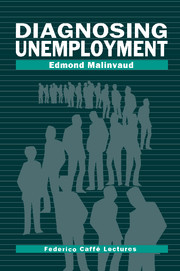Book contents
- Frontmatter
- Contents
- Preface to the Caffé Lectures 1990
- Acknowledgements
- Introduction
- 1 Expert diagnosis
- 2 Analysis and forecasting: their respective roles in mastering our destinies
- 3 From statistics to projections
- 4 Diagnosing unemployment trends
- 5 The Beveridge curve
- 6 Real wages and employment – a decade of analysis
- 7 Profitability and factor demands under uncertainty
- Index
3 - From statistics to projections
Published online by Cambridge University Press: 06 July 2010
- Frontmatter
- Contents
- Preface to the Caffé Lectures 1990
- Acknowledgements
- Introduction
- 1 Expert diagnosis
- 2 Analysis and forecasting: their respective roles in mastering our destinies
- 3 From statistics to projections
- 4 Diagnosing unemployment trends
- 5 The Beveridge curve
- 6 Real wages and employment – a decade of analysis
- 7 Profitability and factor demands under uncertainty
- Index
Summary
Quantitative projections are based on statistics, their sophistication being often constrained by unavailability of data. They rely on a representation of the structure of the phenomenon and in particular of its dynamics. In many applications the model may appear rather simplistic, the main difficulty being the appropriate choice of variables. When modelization requires statistical inference, structural and dynamic aspects are often both relevant, their proper interplay raising delicate issues.
Surveying the use of statistics for projections in the socioeconomic field, this lecture will aim at stimulating reflection on present practices, so as eventually to contribute to their improvement. Some of the most important projections will be first reviewed; the need for better statistical data will then be considered before the role of analytical statistical inference. Section 4 will be devoted to a discussion about the important issue of choosing where to put the main emphasis: on the structural or the dynamic aspects of the phenomenon. This survey moreover raises questions of a fundamental nature about scientific methodology on social and economic matters, questions that will be approached in the concluding section.
Projection practices
A full survey of present projection practices would exhibit their great diversity, even when attention is limited to the socio-economic field. In order to focus the discussion here, only some of them, dealing with population and the economy, will be briefly reviewed.
Demographic projections have for many years been on the agenda of the United Nations Secretariat that has issued many of them, and a series of manuals as well.
- Type
- Chapter
- Information
- Diagnosing Unemployment , pp. 46 - 61Publisher: Cambridge University PressPrint publication year: 1994



